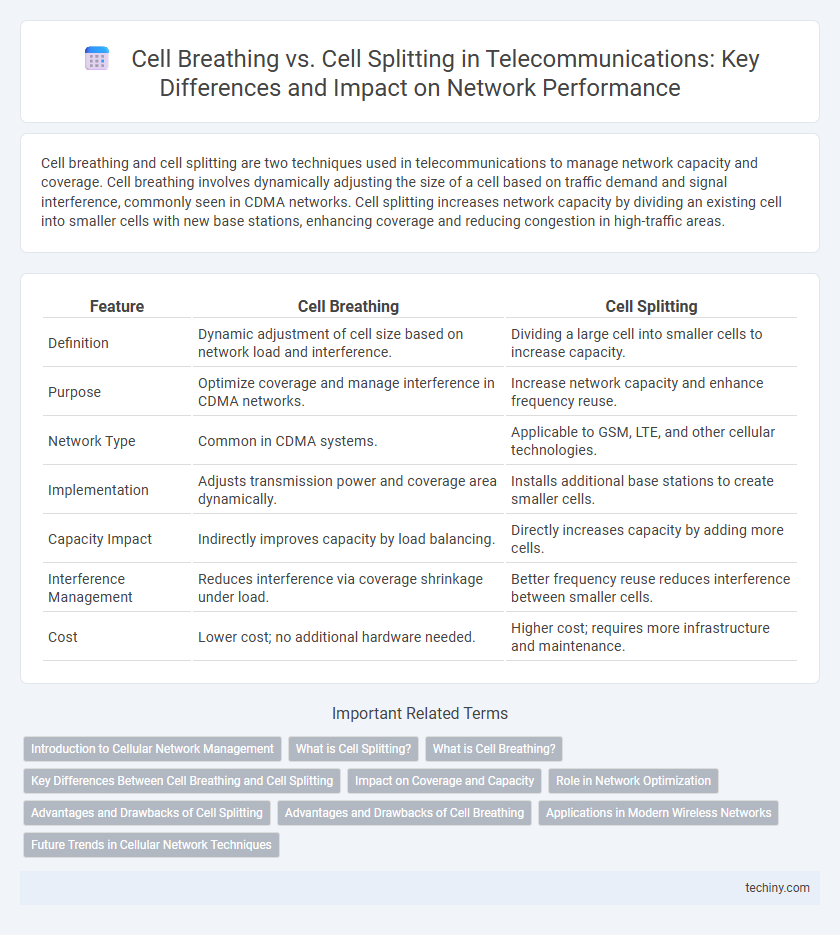Cell breathing and cell splitting are two techniques used in telecommunications to manage network capacity and coverage. Cell breathing involves dynamically adjusting the size of a cell based on traffic demand and signal interference, commonly seen in CDMA networks. Cell splitting increases network capacity by dividing an existing cell into smaller cells with new base stations, enhancing coverage and reducing congestion in high-traffic areas.
Table of Comparison
| Feature | Cell Breathing | Cell Splitting |
|---|---|---|
| Definition | Dynamic adjustment of cell size based on network load and interference. | Dividing a large cell into smaller cells to increase capacity. |
| Purpose | Optimize coverage and manage interference in CDMA networks. | Increase network capacity and enhance frequency reuse. |
| Network Type | Common in CDMA systems. | Applicable to GSM, LTE, and other cellular technologies. |
| Implementation | Adjusts transmission power and coverage area dynamically. | Installs additional base stations to create smaller cells. |
| Capacity Impact | Indirectly improves capacity by load balancing. | Directly increases capacity by adding more cells. |
| Interference Management | Reduces interference via coverage shrinkage under load. | Better frequency reuse reduces interference between smaller cells. |
| Cost | Lower cost; no additional hardware needed. | Higher cost; requires more infrastructure and maintenance. |
Introduction to Cellular Network Management
Cell breathing and cell splitting are essential techniques in cellular network management to optimize coverage and capacity. Cell breathing dynamically adjusts the size of a cell based on traffic load and interference, enhancing network efficiency in real-time. Cell splitting increases network capacity by dividing a congested cell into smaller cells, each with its own base station, thereby reducing the number of users per cell and improving service quality.
What is Cell Splitting?
Cell splitting is a network optimization technique in telecommunications where a larger cell is divided into smaller cells to increase capacity and improve coverage in high-traffic areas. This process reduces the cell size, allowing more users to be served by using additional Base Transceiver Stations (BTS) and frequencies. Cell splitting enhances spectral efficiency and mitigates congestion, especially in urban environments with dense mobile usage.
What is Cell Breathing?
Cell breathing is a dynamic network management technique in telecommunications where a cell tower adjusts its coverage area based on traffic load and interference levels, effectively shrinking or expanding the cell radius. This process helps optimize capacity and maintain service quality by reallocating resources and balancing user demand across adjacent cells. Cell breathing is commonly used in CDMA networks to enhance overall network efficiency and reduce congestion.
Key Differences Between Cell Breathing and Cell Splitting
Cell breathing dynamically adjusts the coverage area of a cell in response to network load and interference, effectively shrinking or expanding the cell to optimize capacity and performance, while cell splitting physically divides a congested cell into smaller cells to increase overall network capacity. The key difference lies in cell breathing's adaptive, real-time modification of cell size without adding new infrastructure, contrasting with cell splitting's permanent expansion through additional base stations or antennas. Cell breathing is commonly used in CDMA and LTE networks for load balancing, whereas cell splitting is a traditional solution predominantly deployed in GSM networks to manage high traffic demand.
Impact on Coverage and Capacity
Cell breathing dynamically adjusts a cell's coverage area based on network load, causing coverage shrinkage during high traffic to maintain quality and prevent congestion, which can reduce signal availability in edge zones. Cell splitting enhances network capacity by dividing a large cell into smaller cells with their own base stations, increasing coverage density and user capacity without compromising signal strength. The trade-off involves cell breathing's flexible coverage at the cost of fluctuating availability, whereas cell splitting delivers consistent coverage expansion but requires more infrastructure investment.
Role in Network Optimization
Cell breathing optimizes network capacity by dynamically adjusting cell size based on traffic load and interference, effectively balancing resource allocation in high-demand areas. Cell splitting enhances network coverage and capacity by dividing congested cells into smaller, more manageable units, enabling increased frequency reuse and reducing call drops. Both techniques play crucial roles in managing network efficiency and improving user experience in evolving cellular environments.
Advantages and Drawbacks of Cell Splitting
Cell splitting enhances network capacity by dividing a congested cell into smaller cells, allowing more simultaneous users and improved signal quality. It requires additional infrastructure investment and may cause increased interference and complex frequency planning. Despite higher costs and management challenges, cell splitting effectively addresses high traffic demand in densely populated areas.
Advantages and Drawbacks of Cell Breathing
Cell breathing in telecommunications extends network capacity by dynamically adjusting cell size based on traffic load, improving overall spectrum efficiency and user experience in congested areas. This technique reduces interference and balances load among neighboring cells but can cause coverage fluctuations, leading to inconsistent service quality during peak times. The adaptability of cell breathing offers cost-effective optimization, yet its reliance on real-time traffic monitoring may introduce complexity in network management.
Applications in Modern Wireless Networks
Cell breathing dynamically adjusts cell size by modulating transmission power to manage network congestion and optimize coverage in CDMA and LTE networks. Cell splitting increases capacity by subdividing congested cells into smaller ones, enabling more users within high-traffic urban environments in 5G and 4G implementations. Combining cell breathing and cell splitting enhances spatial reuse, improves spectral efficiency, and supports seamless handovers in dense wireless deployments.
Future Trends in Cellular Network Techniques
Cell breathing optimizes network capacity by adjusting cell size dynamically based on traffic load, reducing interference in dense urban areas. Cell splitting increases capacity by dividing a cell into smaller cells with more base stations, enhancing coverage and improving data rates in high-demand zones. Future trends include integrating AI-driven adaptive cell breathing with advanced cell splitting strategies to enable ultra-dense networks and seamless 5G and 6G connectivity.
Cell Breathing vs Cell Splitting Infographic

 techiny.com
techiny.com